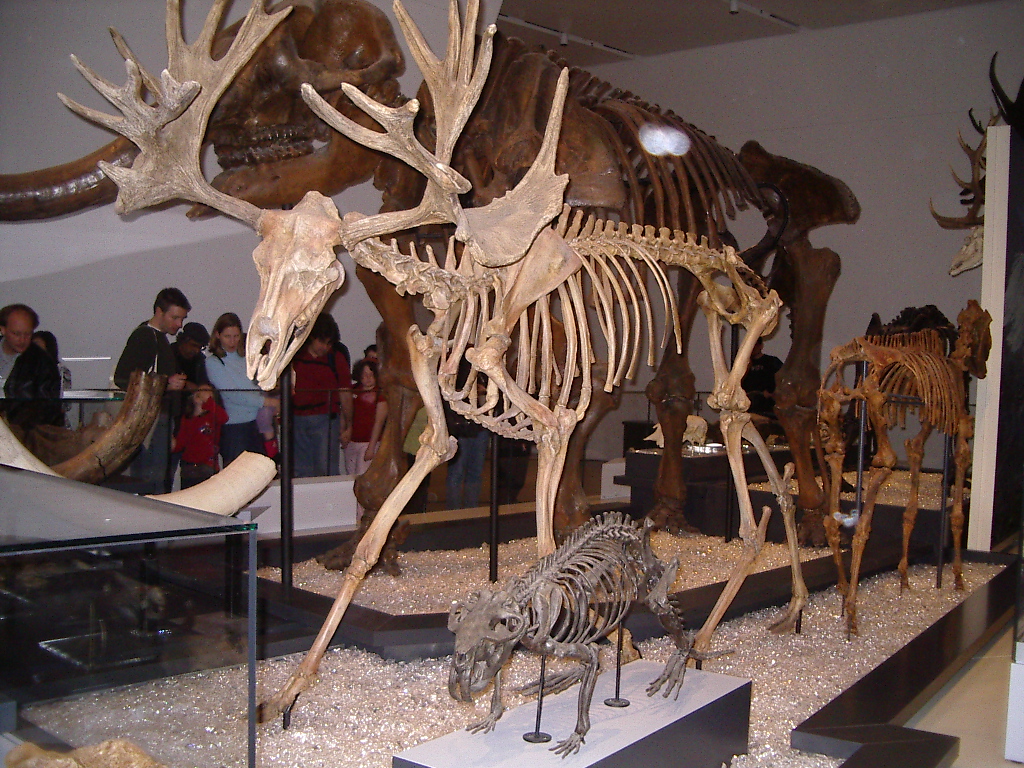- Stag-moose
Taxobox
name = Stag-moose
status = fossil

image_width = 270px
regnum =Animal ia
phylum = Chordata
classis =Mammal ia
ordo =Artiodactyla
familia =Cervidae
genus = †"Cervalces"
genus_authority = Scott, 1885
species = †"C. scotti"
binomial = †"Cervalces scotti"The Stag-moose or Stag moose ("Cervalces scotti") was a largemoose -likedeer ofNorth America of thePleistocene epoch.cite web
url = http://www.ansp.org/museum/jefferson/otherFossils/cervalces.php
title = Stag Moose (Cervalces scotti)
accessdate = 2007-03-03
publisher = TheAcademy of Natural Sciences ] It was slightly larger than the moose, with anelk -like head, long legs, and complex palmate antlers. The species went extinct approximately 11,500 years ago, toward the end of the most recentice age , as part of a mass extinction of large North American mammals. [cite web
url = http://www.museum.state.il.us/exhibits/larson/cervalces.html
title = Stag-moose
accessdate = 2007-03-03
publisher =Illinois State Museum ] cite web
url = http://query.nytimes.com/gst/fullpage.html?res=9B01E1D61531F93AA15757C0A961958260&sec=health&spon=&pagewanted=print
title = Disease Is New Suspect in Ancient Extinctions
accessdate = 2007-03-04
last = Stevens
first = William K.
date = 29
year = 1997
month = April
work =The New York Times ]The first evidence of the stag-moose found in modern times was discovered at
Big Bone Lick ,Kentucky by William Clark, ca. 1805. A more complete skeleton was found in 1885 by William Barryman Scott inNew Jersey .The stag-moose frequented wetlands in a range from southern
Canada toArkansas and fromIowa to New Jersey. As theglacier s retreated, moose (which had crossed theBering land bridge from Asia) [cite web
url = http://books.google.com/books?id=-xQalfqP7BcC&pg=PA931&lpg=PA931&dq=%22stag+moose%22+pleistocene+habitat+bering&source=web&ots=XNo7Bu4054&sig=OEh7aSMIeiv5PSY5dQwz1pkDYrU#PPA931,M1
title = Moose
accessdate = 2007-03-04
author = George A. Feldhamer
coauthors = Joseph A. Chapman, Bruce Carlyle Thompson
year = 1982
work = Wild Mammals of North America: Biology, Management, and Conservation
publisher = Johns Hopkins University Press
pages = 931] may have populated its habitat and caused its extinction by competition. Although there is no paleontological evidence that it was associated with humans, [cite web
url = http://www.amnh.org/science/biodiversity/extinction/Resources/Bestiary/Artiodactyla2.html#Stag-Moose
title = Stag-Moose
accessdate = 2007-03-03
work = Bestiary
publisher =American Museum of Natural History ] other theories for its extinction have been proposed. Notably, there is speculation that hunting by newly-arrived humans caused the extinction of the stag-moose and other large mammals.cite web
url = http://www.nrdc.org/onearth/06win/mammoth1.asp
title = Mammoth Mystery
accessdate = 2007-03-04
author = Sharon Levy
year = 2006
publisher =Natural Resources Defense Council ] Additionally, some have proposed a sudden extinction by disease, brought by small mammals in association with humans.References
External links
* [http://www.isgs.uiuc.edu/education/ice-age-res/stag.shtml Stag Moose Image Gallery]
Wikimedia Foundation. 2010.
